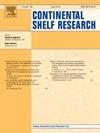全新世海岸地貌演化对Caleta de Los Loros巴塔哥尼亚盐沼水文地球化学的响应
IF 2.2
3区 地球科学
Q2 OCEANOGRAPHY
引用次数: 0
摘要
第四纪期间发生的海平面振荡通过限制该环境中调节水盐度的因素来调节沼泽景观。这项工作的目的是考虑到与阿根廷巴塔哥尼亚沿海地区全新世进化相关的地貌气候因素,评估影响Caleta de Los Loros沼泽地下水盐度的地球化学过程。在这个意义上,基于卫星图像、数字高程模型和实地调查进行了测绘和地貌表征。建立了一个包括地表水和地下水在内的监测网络,以便测量现场pH值和电导率,并在实验室取样以确定主要离子和稳定同位素。研究结果表明,全新世中期至今的地貌演化导致了Caleta de Los Loros沼泽地下水盐度、主要离子组成和同位素信号在潮间带平原不同区域的变化。较老的潮间带沉积物(2100年B.P.)目前位于更大陆的板块,具有高盐度环境,具有高沼泽,植被为盐角藻。水化学和同位素信号表明,在这些沉积物中,盐度主要响应蒸发盐溶解-降水循环。而沿海潮间带沉积物的形成时间大多小于500年,具有生长着米草属植物的低沼泽环境。潮间带的水化学和同位素组成反映了潮水是该系统的主要水贡献,是与地表水相似的沼泽地下水。在当地,也认识到邻近的海滩脊和与CO2(g)溶解有关的水化学变化的贡献。将发生在沼泽中的环境变化作为其第四纪地貌演化的产物来理解,可以理解沼泽中形成的盐度模式的分布,并对这些环境发生盐碱化的时间尺度有一个概念。本文章由计算机程序翻译,如有差异,请以英文原文为准。
Hydrogeochemical evaluation of Caleta de Los Loros Patagonian salt marsh in response to the geomorphological evolution of the coast during the Holocene
Sea level oscillations occurred during the Quaternary conditioned the marsh landscape by limiting the factors that regulate water salinity in this environment. The aim of this work was to evaluate geochemical processes that condition groundwater salinity in Caleta de Los Loros marsh considering geomorphological – climatic factors associated with the Holocene evolution of this Argentinean Patagonia coastal area. In this sense, a mapping and a geomorphological characterization was performed based on satellite images, digital elevation models and field surveys. A monitoring network including both surface and groundwater was made in order to measure in situ pH and electrical conductivity and to take samples to determine major ions and stable isotopes in the laboratory. The set of results obtained highlights that variations in salinity, major ions composition and isotopic signal recorded in the groundwater of Caleta de Los Loros marsh vary in the different sectors of the intertidal plains resulting from geomorphological evolution from the middle Holocene to the present day. The older intertidal deposits (2100 years B.P.) currently located in the more continental sector host high salinity environments with high marshes vegetated with Salicornia sp. The hydrochemical and isotopic signal indicates that in them salinity responds primarily to evaporitic salt dissolution – precipitation cycles. Meanwhile, more coastal intertidal deposits have less than 500 years and they host low marsh environments vegetated with Spartina sp. Hydrochemistry and isotopic composition in them reflect that tidal water flooding is the main water contribution to the system, being marsh groundwater hydrogeochemichally similar to surface water. Locally, contributions from adjacent beach ridges and hydrochemical variations associated with CO2(g) dissolution were also recognized. Understanding environmental changes that occur in marshes as a product of their geomorphological quaternary evolution allows to understand the distribution of salinity patterns that develop in them and to give an idea of the time scale on which the salinization of these environments occurs.
求助全文
通过发布文献求助,成功后即可免费获取论文全文。
去求助
来源期刊

Continental Shelf Research
地学-海洋学
CiteScore
4.30
自引率
4.30%
发文量
136
审稿时长
6.1 months
期刊介绍:
Continental Shelf Research publishes articles dealing with the biological, chemical, geological and physical oceanography of the shallow marine environment, from coastal and estuarine waters out to the shelf break. The continental shelf is a critical environment within the land-ocean continuum, and many processes, functions and problems in the continental shelf are driven by terrestrial inputs transported through the rivers and estuaries to the coastal and continental shelf areas. Manuscripts that deal with these topics must make a clear link to the continental shelf. Examples of research areas include:
Physical sedimentology and geomorphology
Geochemistry of the coastal ocean (inorganic and organic)
Marine environment and anthropogenic effects
Interaction of physical dynamics with natural and manmade shoreline features
Benthic, phytoplankton and zooplankton ecology
Coastal water and sediment quality, and ecosystem health
Benthic-pelagic coupling (physical and biogeochemical)
Interactions between physical dynamics (waves, currents, mixing, etc.) and biogeochemical cycles
Estuarine, coastal and shelf sea modelling and process studies.
 求助内容:
求助内容: 应助结果提醒方式:
应助结果提醒方式:


